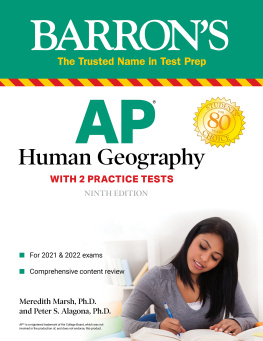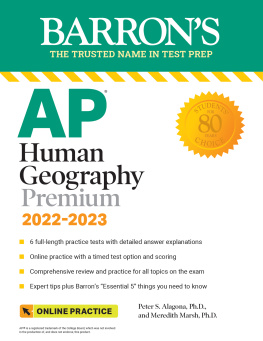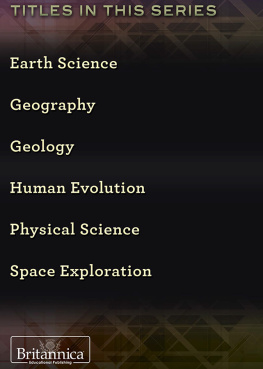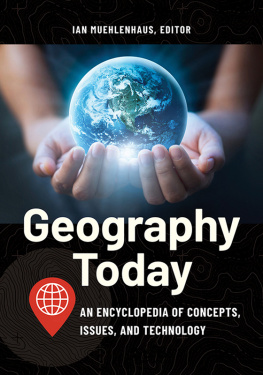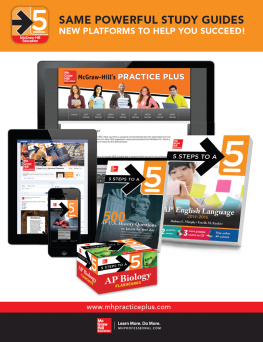
ACKNOWLEDGMENTS
First, Id like to thank Pete Alagona (my co-author) and Jennifer Giammusso (my editor). I appreciate the humor Pete consistently brings to this project and the leadership that Jennifer provides. Second, Id like to recognize my peers and students from the University of California at Santa Barbara and Lindenwood University, who consistently provide professional support. Finally, Id like to thank my family, most importantly my Mom, as she watched my 4-year-old daughter, Lucy, while I struggled to design 150 new, unique, and challenging multiple-choice questions!
Meri Marsh, Ph.D.
September 2011
This book has become something of an old friend. It has appeared and reappeared in my life many times over the past several years. Each time it reappears it brings back old memories and leaves me with new ones. Many people have made this volume possible. My family, friends, mentors, and students have all played important roles. My wife, Jessica, makes everything I do possible, and whenever I work Bodie is always by my side. Most of all, however, this book owes its existence to my friend and colleague, Meri Marsh, without whom it would never have reached a first draft, much less a fourth edition.
Peter S. Alagona, Ph.D.
Santa Barbara, California
September 2011
ABOUT THE AUTHORS
Meredith J. Marsh received her bachelors degree in geography from Calvin College in 1999, her Masters Degree in geography from the University of California Santa Barbara (UCSB) in 2003, and her Ph.D. (also in geography) from UCSB in 2009. Meredith has worked as a Reader for the APHG exam in 2007, 2009, 2010, and 2011 and is currently a professor of geography at Linden wood University in St. Charles, Missouri.
Peter S. Alagona is an assistant professor of history and environmental studies at the University of California, Santa Barbara. He holds an M.A. degree in geography from the University of California, Santa Barbara, and M.A. and Ph.D. degrees in history from the University of California, Los Angeles. He has also held academic positions at both Harvard and Stanford universities.
Copyright 2012, 2010, 2008 by Barrons Educational Series, Inc.
Previous edition copyright 2003 under the title
How to Prepare for the AP Human Geography Exam
by Barrons Educational Series, Inc.
All rights reserved.
No part of this publication may be reproduced in any form or by any means without the written permission of the copyright owner.
All inquiries should be addressed to:
Barrons Educational Series, Inc.
250 Wireless Boulevard
Hauppauge, New York 11788
www.barronseduc.com
eISBN: 978-1-4380-8345-2
First e-Book publication: February, 2012
ISSN: 2163-7849

Whats New in the 4th Edition
About the Book
About the Test
Strategies for Preparing for the Exam
Commonly Asked Questions About the AP Human Geography Exam
Additional Resources
*Please note: This e-Book will appear differently depending on what e-reader device or software you are using to view it. Please adjust accordingly.
Although it contains much of the original content from the previous editions, Barrons 4th Edition of AP Human Geography has been updated in order to prepare students better for the exam. The first chapter has been extensively revised to reflect more accurately the structure of the exam. The content chapters following have also been revised and updated to ensure that students knowledge of human geography is current and comprehensive. Finally, perhaps the greatest change to this edition was revising the free-response questions (FRQs) on the diagnostic and model tests to reflect the content and structure of questions appearing on past exams more closely. Each FRQ is now accompanied with an extensive rubric that allows teachers and students using this book to grade practice tests more accurately, thereby strengthening students preparation for exam day.
The AP Human Geography Exam covers a range of material that would normally be included in a semester-long college-level course in Introductory Human Geography. These courses typically cover a wide variety of topics, with the basic goal of understanding patterns and processes that have shaped human relationships on earth over space and time. This overarching goal can be further divided into a set of goals derived from the National Geography World Literacy Standards, introduced in 1994. According to the College Board, which adheres to these standards, upon completion of an Introductory Human Geography course, students should be able to:
Use and think about maps and spatial data sets,
Understand and interpret the implications of associations among phenomena in places,
Recognize and interpret at different scales the relationships among patterns and processes,
Characterize and analyze changing interconnections among places.
The APHG Exam covers seven major content areas. Each content area, described later in this chapter, will make up a certain percentage of the exam. This book has been designed to correspond with the College Boards objectives, and one chapter is dedicated to each of the Boards seven major content areas, with the exception of the first content area: Geography, its Nature and Perspectives, which has been divided into two chapters. Each chapter contains content knowledge about the topic under discussion, tips on preparing for the exam, and practice multiple-choice and free-response questions with answers explained.
This eBook provides hundreds of links that will help you navigate through the books content, bring you to helpful resources, and allow you to click between practice questions and answers.
The AP Human Geography exam contains two sections and lasts for two hours and 15 minutes. The first section includes 75 multiple-choice questions; students are given 60 minutes to complete this portion of the exam. In the remaining 75 minutes, students answer three free-response essay questions.
The test covers seven different content areas; see the outline below to gain a better understanding of the major topics covered and the percentage of the exam dedicated to each topic:
I. Geography: Its Nature and Perspectives: 510% (48 questions)
A. Geography as a field of inquiry
B. Evolution of key geographical concepts and models associated with notable geographers
C. Key concepts underlying the geographical perspective: location, space, place, scale, pattern, regionalization, and globalization
D. Key geographical skills
1. How to use and think about maps and spatial data
2. How to understand and interpret the implications of associations among phenomena in places
3. How to recognize and interpret at different scales the relationships among patterns and processes
4. How to define regions and evaluate the regionalization process
5. How to characterize and analyze changing interconnections among places
E. Geographic technologies, such as GIS, remote sensing, and GPS
F. Sources of geographical ideas and data: the field, census data, and satellite imagery
II. Population: 1317% (1013 questions)
A. Geographical analysis of population
1. Density, distribution, and scale
2. Implications of various densities and distributions
3. Patterns of composition: age, sex, race, and ethnicity
4. Population and natural hazards: past, present, and future
B. Population growth and decline over time and space
1. Historical trends and projections for the future
Next page


